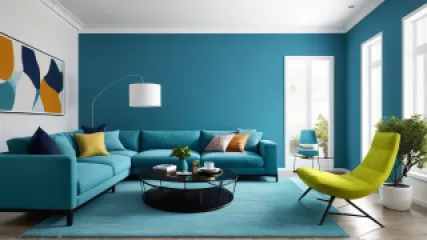How Color Psychology Can Transform Your Home Interiors
How Color Psychology Can Transform Your Home Interiors
As an interior designer, I've always been fascinated by the profound impact that color can have on our emotions, our moods, and our overall well-being. Color is not just a matter of aesthetic preference – it's a powerful tool that can shape our psychological and physiological experiences within the spaces we inhabit. In this opinion piece, I'll explore how a deeper understanding of color psychology can help transform your home interiors in ways that enhance your mood, improve your mental health, and create a more harmonious living environment.
The Emotional Impact of Color
Color is not simply a visual phenomenon; it's a multisensory experience that can elicit profound emotional responses. Research in color psychology has shown that different hues can have a significant impact on our mood, cognition, and even physical well-being. For example, studies have found that warm colors like red and orange can stimulate feelings of energy, passion, and excitement, while cool colors like blue and green can promote a sense of calm, tranquility, and relaxation.
But the emotional impact of color goes beyond these broad generalizations. Each individual color has its own unique psychological associations and symbolism that can be leveraged in interior design to create specific desired effects. Yellow, for instance, is often associated with feelings of happiness, optimism, and creativity, making it an excellent choice for spaces where you want to foster a sense of positivity and inspiration. On the other hand, purple can evoke a sense of luxury, sophistication, and even a touch of mysticism, making it a compelling option for more formal or contemplative areas of the home.
Enhancing Mood and Well-Being with Color
Given the powerful emotional impact of color, it's no surprise that it can also play a significant role in our overall mental health and well-being. Studies have shown that the colors we surround ourselves with can have a profound influence on our mood, stress levels, and even our cognitive performance. By thoughtfully incorporating color into our home interiors, we can create environments that support our mental and emotional needs, rather than contributing to feelings of anxiety, depression, or fatigue.
For instance, the soothing, calming properties of blue can be particularly beneficial in bedrooms and other areas where we seek rest and relaxation. Conversely, the energizing qualities of red and orange may be better suited to home offices, gyms, or other spaces where we need to feel motivated and alert. And the cheerful, uplifting nature of yellow can be leveraged in shared living areas to foster a sense of joy and community.
The Psychology of Color in Interior Design
As an interior designer, I've seen firsthand how the strategic use of color can transform a space and the way it makes people feel. When it comes to designing a home that supports mental health and well-being, color psychology should be a key consideration. By understanding the emotional and psychological associations of different hues, we can create interiors that not only look aesthetically pleasing but also actively contribute to our overall sense of calm, focus, and contentment.
For example, in a home office, the use of blues and greens can promote a sense of focus and productivity, while pops of yellow or orange can help to energize and inspire. In a meditation or yoga studio, soothing shades of lavender or sage can create a serene, contemplative atmosphere. And in a cozy living room, warm neutrals like beige and taupe can foster a feeling of comfort and security.
Balancing Color for Harmony and Wellbeing
Of course, the strategic use of color in interior design is not just about choosing individual hues; it's also about striking the right balance and creating a cohesive, harmonious palette. By thoughtfully combining complementary colors, analogous colors, or even monochromatic schemes, we can create spaces that feel visually and emotionally balanced.
This balance is crucial for our overall well-being, as jarring color combinations or overly chaotic palettes can contribute to feelings of stress, anxiety, and visual fatigue. On the other hand, a carefully curated color scheme that reflects our personal preferences and psychological needs can foster a sense of calm, clarity, and contentment – a true sanctuary for the mind and body.
Personalizing Color Choices for Your Home
While the principles of color psychology can provide a helpful framework for interior design, it's important to remember that our individual responses to color are highly personal and subjective. What might be calming and soothing for one person could be overstimulating or even depressing for another. As such, it's essential to approach color choices with a deep understanding of your own unique emotional and psychological needs.
When selecting colors for your home, consider not only the general principles of color psychology but also your own personal associations, preferences, and lived experiences. What colors make you feel most at ease? Which hues inspire you and bring you joy? By aligning your color choices with your individual needs and preferences, you can create a home environment that truly nourishes your mind, body, and spirit.
Conclusion: Embracing the Power of Color
In conclusion, color psychology is a powerful tool that can transform the way we experience and interact with our home interiors. By understanding the emotional and psychological impact of different hues, we can create spaces that support our mental health, enhance our mood, and foster a greater sense of well-being. Whether you're drawn to the calming influence of blues and greens or the energizing properties of reds and oranges, embracing the power of color can be a truly transformative experience for your home and your overall quality of life.
So, as you embark on your next interior design project, I encourage you to delve deeper into the world of color psychology and let it guide your creative vision. Unlock the transformative potential of color and create a home that not only looks beautiful but also nourishes your mind, body, and soul.






